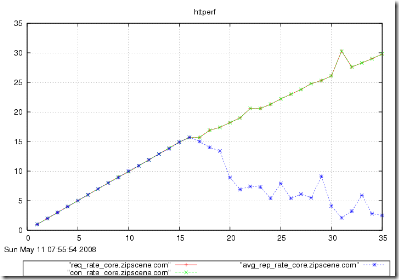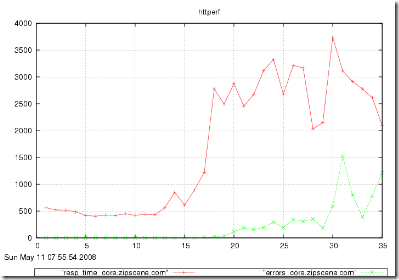I’ve mentioned Apache Bench before. Httperf serves the same purpose as ab, but has a few more features, and has one very nice value-add.
While ab cannot really simulate a user visiting a website and performing multiple requests, httperf can. You can feed it a number of URL’s to visit, and specify how many requests to send within one session. You can also spread out requests over a time period randomly according a uniform or Poisson distribution, or a constant.
But the big value-add is autobench. Autobench is a perl wrapper around httperf for automating the process of load testing a web server. Autobench runs httperf a specified number of times against a URI, increasing the number of requests per second (which I equate to -c in ab) so that the response rate or the response time can be graphed vs. requests per second. (So response rate or response time on the vertical, and requests per second on the horizontal.)
With this, you can generate pretty graphs like this:
From the graphs above, you could determine the approximate capacity of your website. In the first graph, the number of responses received was equal to the number of requests sent until 16 req/sec. At 16 req/sec., the number of responses starts going down as requests begin to error out. In the second graph, the response time stays level at about 500ms (a reflection of your code and database) until 15 req/sec. At 16 req/sec. the time goes up to nearly 1s, and at 17 req/sec. the response time is over a second. You would conclude that the capacity of this website is around 15 requests per second.
The people who provide autobench also offer an excellent HOWTO on benchmarking web servers in general.







